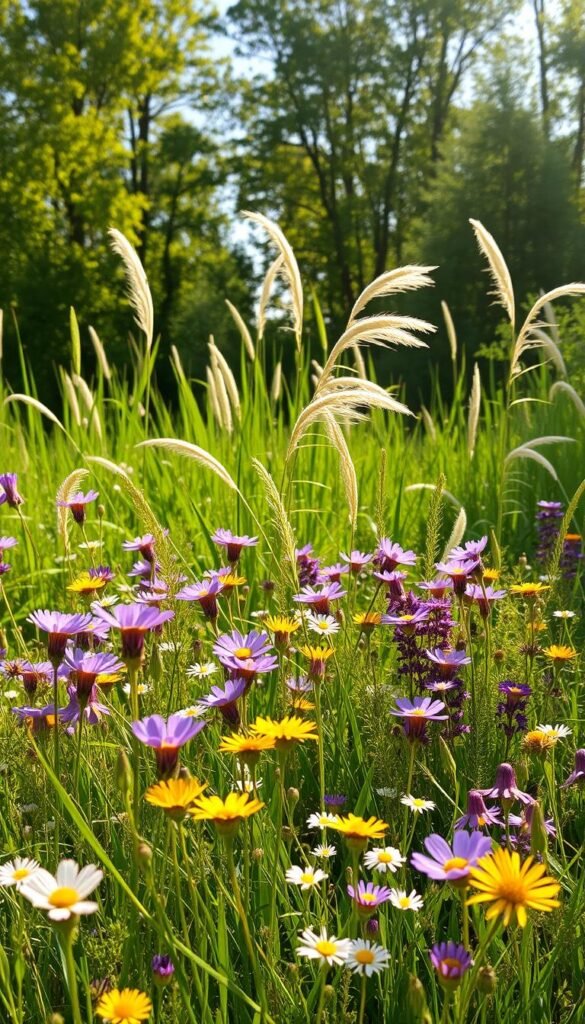Imagine stepping outside to a vibrant tapestry of colors buzzing with life. Traditional wildflower habitats have vanished by over 97% since the 1930s, but your yard could become a lifeline for struggling ecosystems. By rethinking even a small slice of grass, you can create a thriving refuge for bees, butterflies, and birds while adding natural beauty to your landscape.
Unlike uniform turf, a biodiverse space teems with native blooms that feed pollinators and grasses that shelter small creatures. Experts note that simply adjusting mowing schedules lets nature reclaim areas naturally. This approach not only supports endangered species but also reduces maintenance compared to thirsty lawns.
You’ll discover how these spaces balance chaos and charm, blending seamlessly with any gardening style. From selecting regional seeds to managing growth cycles, we’ll guide you through each step. Ready to trade weekly mowing for seasonal surprises? Your backyard adventure starts here.
Understanding the Benefits of a Wildflower Meadow
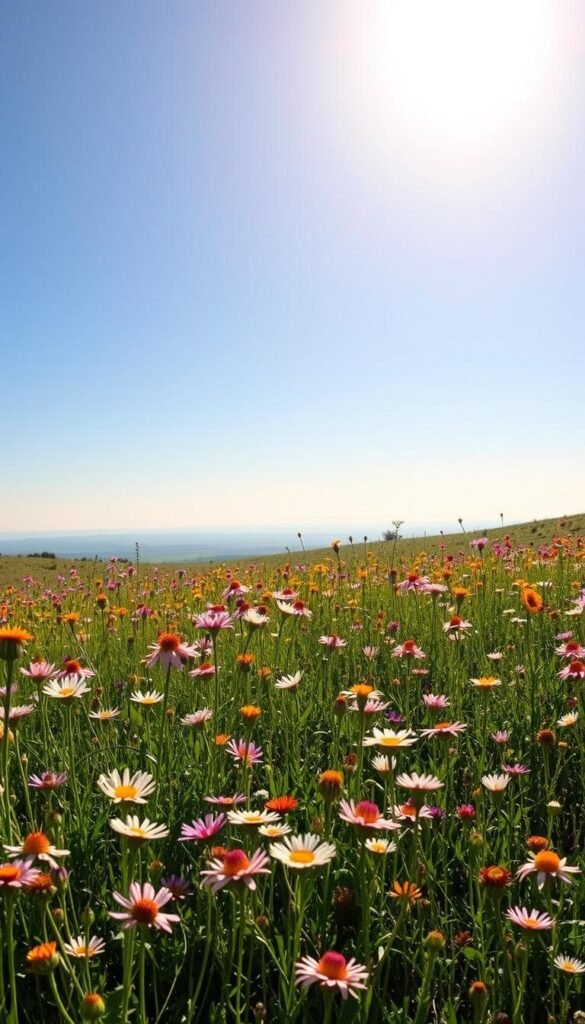
Transforming even a small patch of grass can yield big rewards for nature and your backyard. These vibrant spaces burst with life while cutting your yard work in half. Let’s explore why these ecosystems matter more than ever.
Biodiversity and Pollinator Support
Wildflower meadows shelter six times more species than lawns, from buzzing bees to hungry birds. Since 2000, insect populations dropped by 60%, but your blooms can reverse this trend. Native flowers feed butterflies and moths, while tall grasses hide frogs and hedgehogs.
Birds flock to these areas for insect meals, creating natural pest control. Bats join the feast at dusk, keeping mosquitoes in check. Over time, your space becomes a highway for wildlife moving between fragmented habitats.
Eco-Friendly and Low-Maintenance Advantages
Swap weekly mowing for seasonal trims. Unlike thirsty grass, established meadows thrive on rainfall alone. No fertilizers or pesticides mean cleaner groundwater and healthier soil microbes.
| Aspect | Traditional Lawn | Wildflower Meadow |
|---|---|---|
| Mowing Frequency | Weekly | 1-2 times yearly |
| Water Needs | High | Low |
| Carbon Storage | 0.5 lbs/sq.ft | 2.1 lbs/sq.ft |
| Wildlife Species Supported | 3-5 | 25+ |
Deep-rooted flowers prevent erosion and store carbon better than turfgrass. You’ll save 80% on lawn care costs while giving pollinators a fighting chance. It’s a win for your wallet and the planet.
Planning Your Mini Meadow: Converting Part of Your Lawn into a Wild Flower Garden
Creating a thriving pollinator habitat starts with smart preparation. Let’s map out your transformation strategy to ensure success from day one.
Defining Your Vision and Scope
Start by measuring your available space. Even a 10×10 foot area can host 30+ native plant species. Consider sunlight patterns – most wildflowers need 6+ hours of direct light. Sketch rough boundaries using garden stakes or spray paint.
Assessing Your Lawn and Soil Conditions
Test your soil using a $10 kit from any garden center. Most meadow plants prefer pH levels between 5.5-7.0. Check drainage by digging a 12-inch hole – if water remains after 24 hours, choose moisture-loving species.
| Soil Type | Best Wildflowers | Drainage Fixes |
|---|---|---|
| Clay | Black-eyed Susan | Add compost |
| Sandy | Blanket Flower | Mulch surface |
| Loamy | Coneflower | None needed |
For compacted ground, aerate before planting. Blend your seed mix to match local conditions – drought-tolerant varieties for slopes, taller grasses for wet zones. Remember, a well-planned wildflower garden becomes its own ecosystem within 2-3 seasons.
Preparing Your Lawn for Conversion
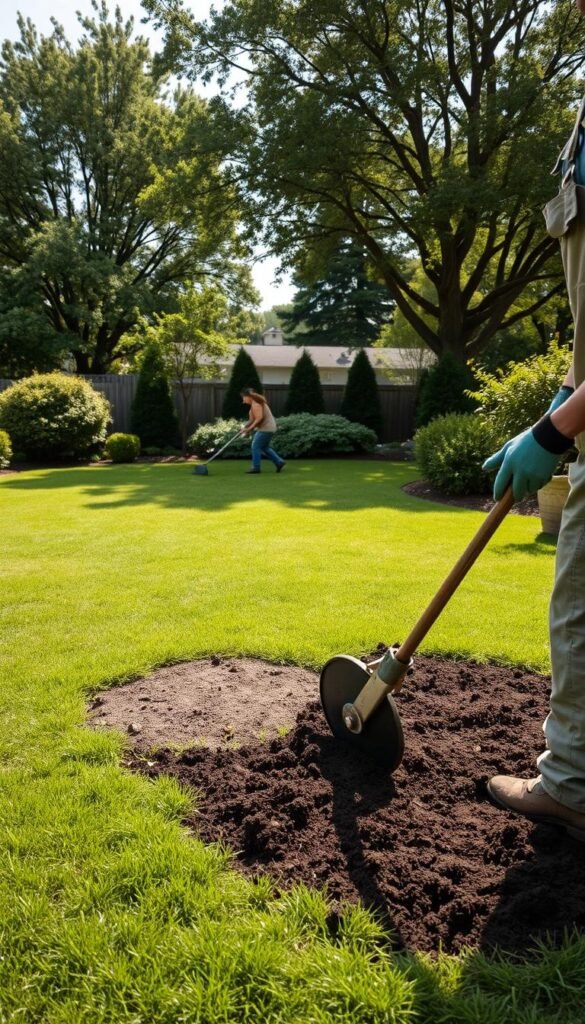
Your journey to a thriving habitat starts with proper groundwork. Removing existing turf gives wildflowers their best chance to establish deep roots and outcompete weeds. Let’s break down the most effective strategies for clearing space while protecting your soil’s health.
Methods for Lawn Removal
Manual removal works best for small areas. Use a flat spade to slice through grass roots or rent a sod cutter for larger spaces. This method gives instant results but requires physical effort. For those preferring a chemical-free approach, smothering grass with cardboard or black plastic takes 6-12 weeks – perfect for summer projects.
Mechanical tilling quickly clears extensive lawns but risks awakening dormant weed seeds. If using herbicides, apply them during active growth periods and remove dead vegetation afterward. Always wear protective gear and follow label instructions carefully.
Before breaking ground, call 811 to locate underground utilities. Check local regulations if you’re part of a homeowner association. Map sprinkler heads and irrigation lines to avoid costly repairs – essential steps whether you’re creating a wildflower haven or transforming grass into a productive vegetable.
| Method | Time Required | Best For |
|---|---|---|
| Manual Removal | 1-3 days | Small plots |
| Smothering | 6-12 weeks | Chemical-free |
| Tilling | 2-4 hours | Large areas |
Each technique impacts soil structure differently. Manual methods preserve earthworm tunnels, while tilling improves aeration in compacted ground. Test your soil after removal and amend with compost if needed before seeding.
Planting Techniques and Timing
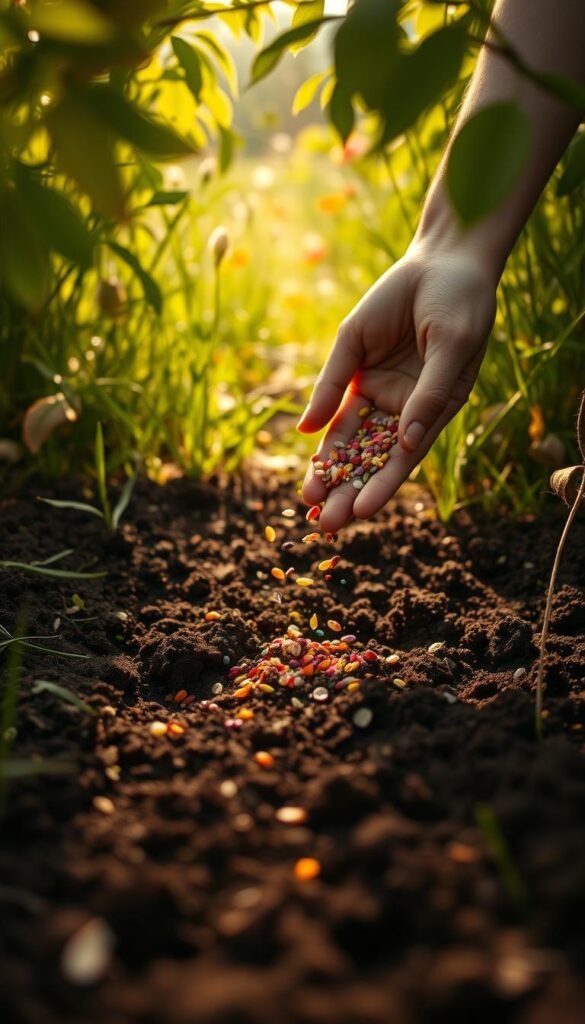
Your wildflower success begins with smart planting choices. Timing and method determine whether your blooms flourish or struggle. Let’s explore how to work with nature’s schedule while balancing effort and results.
Sowing Seeds versus Planting Plugs
Seeds offer budget-friendly coverage for large spaces – mix 1 pound with 8 gallons of sand for even spreading. Scatter in early spring after frost risks pass, or autumn for quick germination in sandy soils. Press seeds into dirt but don’t bury them – sunlight triggers growth.
Plugs (young plants) jumpstart meadows in small areas. Create your own by:
- Sowing seeds in trays during winter
- Keeping them in unheated spaces
- Transplanting when roots fill containers
Store-bought plants cost 3x more but guarantee specific varieties. Mix both approaches – use plugs for slow-growing perennials and seeds for annual color bursts.
Selecting the Ideal Season for Wildflower Growth
Soil type dictates your planting window. Loose, sandy earth? Try autumn sowing – moisture and cool temps help roots establish. Heavy clay? Wait until mid-spring when ground warms.
| Planting Time | Best For | Care Tips |
|---|---|---|
| Early Spring | Cold-stratified seeds | Water lightly daily |
| Late Fall | Native perennials | Mulch with straw |
Check forecasts – sudden frosts kill tender seedlings. If planting in winter, choose species needing cold periods to sprout. Remember: most mixes take 2-8 weeks to germinate. Patience rewards you with waves of blooms!
Caring for Your Establishing Meadow
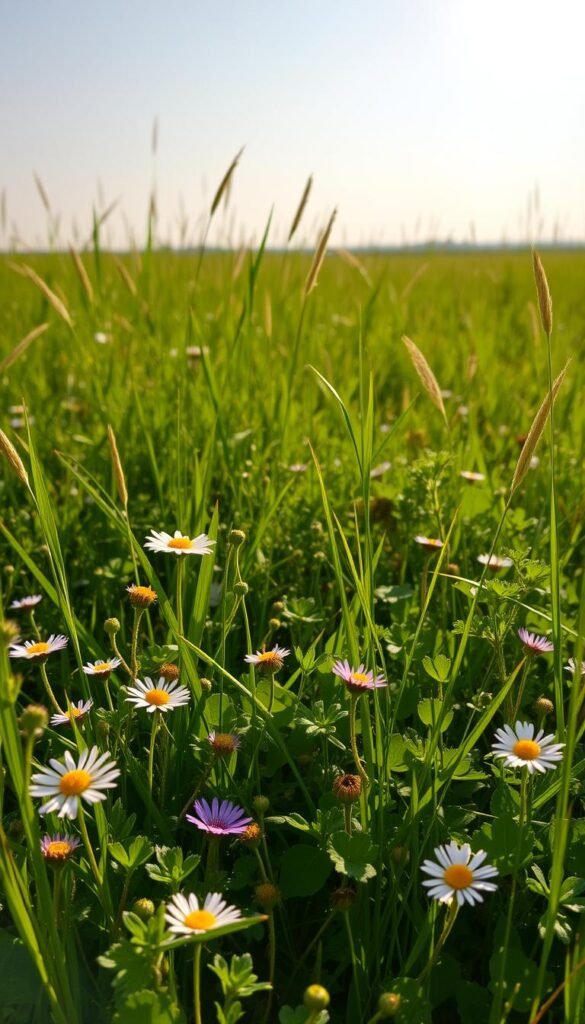
Your blooming habitat needs thoughtful care during its first seasons. Proper maintenance ensures strong root systems and diverse blooms while protecting local creatures.
Seasonal Maintenance Essentials
Cut plants to 2-3 inches when they reach 4-8 inches tall during year one. This controls weeds while letting native species strengthen. Always inspect for wildlife – gently relocate caterpillars or toads before trimming.
Schedule major cuts between late July and September. Choose dry days to prevent mold growth. After mowing, leave clippings for 48 hours. This lets seeds drop naturally. Then remove debris to keep soil nutrient levels balanced.
| Task | First Year | Established Meadow |
|---|---|---|
| Watering | Weekly | Only in droughts |
| Weeding | Hand-pull monthly | Spot treatment |
| Cutting Height | 2-3 inches | 4-6 inches |
Water seedlings lightly every morning for three weeks. Established plants thrive on rainfall alone. Watch for invasive species like thistle – remove them before seed heads form. Your patience pays off: most meadows reach full beauty in 2-3 years.
Incorporating Native Plants for Enhanced Biodiversity
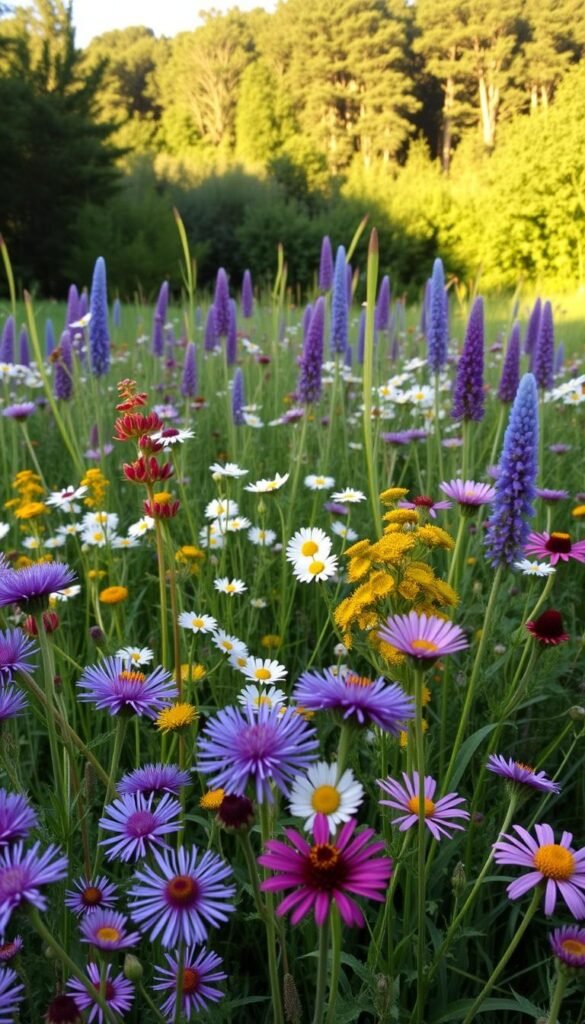
Strategic plant choices turn your space into a resilient habitat teeming with life. Native wildflowers and grasses form the foundation of thriving ecosystems, supporting local wildlife while requiring minimal care. Let’s explore top performers that bring color and vitality to your landscape.
Black-eyed Susan dazzles with golden blooms in its first year, reseeding generously for recurring displays. Pair it with Purple Coneflower – a pollinator favorite offering nectar-rich flowers from June through September. These perennials anchor your meadow while providing winter food for birds.
For vertical drama, plant Blazing Star. Its purple spikes attract butterflies in midsummer, creating living insect hotels. Complement these with low-maintenance grasses like Blue Grama, which adds texture and shelters moth larvae. Together, these plants create layered habitats supporting over 25 species.
| Plant | Key Features | Bloom Time |
|---|---|---|
| Common Milkweed | Monarch host plant | June-July |
| Wild Bergamot | Attracts hummingbirds | July-August |
| Blazing Star | Butterfly magnet | Mid-summer |
| Blue Grama Grass | Drought-resistant | Year-round |
Include Common Milkweed to sustain monarch butterflies – their sole larval food source. Wild Bergamot adds aromatic foliage and dual-purpose blooms, perfect for creating a pollinator haven that delights kids and adults alike. These natives thrive in local soils, needing no fertilizers or extra watering once established.
Mix early and late bloomers for continuous color. Cluster similar wildflower types in groups of five to create natural drifts. Within two seasons, your space becomes a self-sustaining sanctuary where every plant serves multiple ecological roles.
Adapting Your Mini Meadow for Small Spaces and Raised Beds
Think big by starting small. Even a balcony or patio can host thriving blooms with smart design choices. Raised beds and containers let you craft micro-habitats anywhere sunlight reaches.
Creative Solutions for Limited Areas
Transform unused corners into pollinator pitstops. A 4×4-foot planter box works perfectly for native plants like coreopsis and penstemon. Use vertical space with trailing varieties in hanging baskets.
Mix quick-blooming annuals with perennial favorites for nonstop color. Zinnias and cosmos add instant impact while slower-growing milkweed establishes. This combo keeps your wildflower areas lively from spring through frost.
For renters or small yards, try modular containers. Group movable pots to create seasonal displays. You’ll enjoy flexibility while providing essential food sources. Remember: multiple small spaces collectively make a big ecological difference.
Start with one manageable plot this season. Observe what thrives, then expand next year. Your evolving habitat will naturally adapt to local conditions, becoming a personalized sanctuary for winged visitors.

